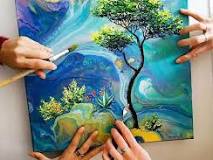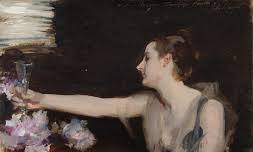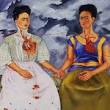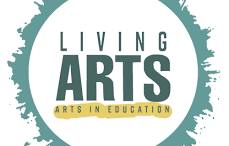The Power of Visual Art: A Window to the Soul
Visual art has long been recognized as a powerful medium of expression that transcends language and culture. From ancient cave paintings to modern digital creations, artists have used visual elements such as color, form, and composition to communicate ideas, emotions, and experiences.
One of the unique qualities of visual art is its ability to evoke a wide range of emotions and provoke thought in viewers. A painting, sculpture, or photograph can capture the essence of a moment, convey a message, or challenge societal norms. Through the use of symbolism, metaphor, and visual storytelling, artists create works that resonate with audiences on a deep and personal level.
Visual art also serves as a mirror reflecting the artist’s inner world. Each brushstroke or sculpted form is a manifestation of the artist’s thoughts, feelings, and perspectives. By immersing themselves in the creative process, artists are able to explore their own identity and connect with others on a profound level.
Furthermore, visual art has the power to inspire change and foster empathy. Through themes of social justice, environmental awareness, or personal struggles, artists can shine a light on important issues and spark meaningful conversations. Art has the capacity to unite people from diverse backgrounds and create a shared understanding of the human experience.
In today’s fast-paced world filled with distractions, visual art offers a sanctuary for contemplation and reflection. Whether admiring a masterpiece in a museum or creating art in one’s own space, individuals can find solace in the beauty and complexity of artistic expression.
Ultimately, visual art serves as a window to the soul – revealing our deepest desires, fears, and aspirations. It invites us to see the world through fresh eyes and explore new possibilities. As we engage with visual art, we embark on a journey of self-discovery and connection that enriches our lives in profound ways.
9 Essential Tips for Enhancing Your Visual Art Skills and Discovering Your Unique Style
- Experiment with different art mediums and techniques to discover your unique style.
- Study the works of famous artists to gain inspiration and learn new approaches.
- Pay attention to composition, balance, and contrast in your artwork.
- Use color theory to evoke different emotions and create visually appealing pieces.
- Practice regularly to improve your skills and develop consistency in your work.
- Don’t be afraid to take risks and think outside the box with your artistic choices.
- Seek feedback from other artists or art enthusiasts to get valuable insights on your work.
- Take breaks when needed to prevent burnout and maintain creativity.
- Enjoy the process of creating art and let it be a form of self-expression.
Experiment with different art mediums and techniques to discover your unique style.
To truly unlock your creative potential in visual art, it is essential to embrace experimentation with various art mediums and techniques. By exploring different tools, materials, and approaches, you can uncover your distinct artistic style that sets you apart. Whether it’s through painting, sculpting, mixed media, or digital art, each new experiment offers a chance to push boundaries, break conventions, and find innovative ways to express your creativity. Embrace the journey of discovery as you navigate through diverse mediums and techniques to carve out your own artistic identity and leave a lasting impression with your unique visual language.
Study the works of famous artists to gain inspiration and learn new approaches.
Studying the works of famous artists is a valuable tip for anyone looking to delve deeper into the world of visual art. By immersing oneself in the masterpieces created by renowned artists, one can gain inspiration, insight, and a deeper understanding of different artistic approaches. Analyzing the techniques, styles, and concepts employed by these masters not only sparks creativity but also provides a rich source of knowledge to enhance one’s own artistic practice. Through studying the works of famous artists, aspiring artists can expand their artistic horizons and discover new ways to express themselves creatively.
Pay attention to composition, balance, and contrast in your artwork.
When creating visual art, it is essential to pay close attention to composition, balance, and contrast. The way elements are arranged within the artwork can greatly impact its overall impact and effectiveness. Composition refers to the arrangement of visual elements such as lines, shapes, colors, and textures within the piece. Achieving a harmonious balance between these elements helps create a sense of unity and coherence in the artwork. Additionally, utilizing contrast – whether in colors, tones, or textures – can add depth and visual interest to the composition, drawing the viewer’s eye and enhancing the overall aesthetic appeal of the piece. By carefully considering composition, balance, and contrast in your artwork, you can create a visually compelling and engaging work that resonates with viewers on a deeper level.
Use color theory to evoke different emotions and create visually appealing pieces.
Color theory plays a crucial role in the world of visual art, allowing artists to evoke specific emotions and create visually appealing pieces. By understanding the psychological impact of colors, artists can strategically choose palettes that resonate with viewers on a subconscious level. Warm tones like red and orange can convey energy and passion, while cool tones like blue and green evoke calmness and tranquility. Complementary color schemes create contrast and visual interest, while monochromatic schemes offer harmony and unity. Through the deliberate use of color theory, artists can infuse their artworks with depth, meaning, and emotional resonance, captivating audiences and enriching their artistic expressions.
Practice regularly to improve your skills and develop consistency in your work.
To enhance your proficiency and cultivate a consistent artistic style in visual art, it is essential to engage in regular practice. By dedicating time to honing your skills and exploring different techniques, you can refine your craft and expand your creative repertoire. Consistent practice not only strengthens your abilities but also fosters a deeper understanding of your artistic voice, allowing you to express yourself more authentically through your work. Embrace the journey of continuous learning and growth through regular practice, as it is the key to unlocking your full potential as an artist.
Don’t be afraid to take risks and think outside the box with your artistic choices.
In the realm of visual art, embracing risk-taking and venturing beyond conventional boundaries can lead to extraordinary creative breakthroughs. By daring to think outside the box and exploring uncharted territories in artistic expression, artists can uncover new perspectives, innovative techniques, and unique forms of self-expression. Stepping out of one’s comfort zone allows for growth, experimentation, and the discovery of untapped potential within one’s artistic vision. Embracing risks in art opens doors to endless possibilities and paves the way for truly transformative and captivating creations that resonate deeply with both the creator and the audience.
Seek feedback from other artists or art enthusiasts to get valuable insights on your work.
Seeking feedback from other artists or art enthusiasts can provide valuable insights into your work. By opening yourself up to constructive criticism and different perspectives, you can gain a deeper understanding of how your art is perceived and ways to improve it. Engaging with a community of fellow creatives allows for meaningful discussions, exchange of ideas, and growth as an artist. Embracing feedback not only enhances the quality of your work but also fosters a sense of connection and collaboration within the artistic community.
Take breaks when needed to prevent burnout and maintain creativity.
In the realm of visual art, it is crucial to recognize the importance of taking breaks when necessary to prevent burnout and sustain creativity. Artists often immerse themselves in their work for extended periods, pushing the boundaries of their imagination and skills. However, stepping back and allowing time for rest and rejuvenation is essential to avoid mental fatigue and maintain a fresh perspective. By taking breaks, artists can recharge their creative energy, gain new insights, and approach their work with renewed passion and clarity. This practice not only enhances artistic output but also nurtures overall well-being, fostering a balanced and sustainable creative process.
Enjoy the process of creating art and let it be a form of self-expression.
When engaging in visual art, it is important to embrace the process of creation as a means of self-expression. Allow yourself to immerse in the act of making art, letting go of expectations and embracing spontaneity. By enjoying the journey of creating art, you can tap into your inner thoughts, emotions, and experiences, translating them into visual form. Let each brushstroke or sculpted detail reflect a part of yourself, allowing your unique voice to shine through in your artistic endeavors. Embracing the process of creating art as a form of self-expression can be a liberating and fulfilling experience that allows you to connect with your inner creativity on a deeper level.





